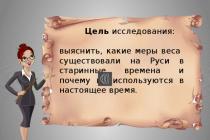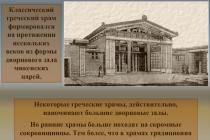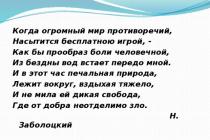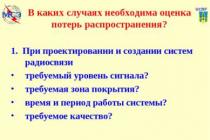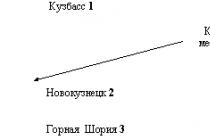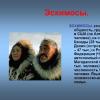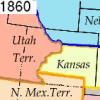Kostina Kristina
Gracovova Irina
Popenko Polina
2012Nowadays we, without thinking, produce
calculations in meters, grams, liters, etc.
This is convenient, a single system SI suits
almost everyone. But, naturally, it was not always.
And so, starting from the oldest times of paganism,
up to the 19th century, our ancestors used
Other measures and units. Often we
We hear words: powder, soy, spool - but,
How much is in translation, do not know. Here are some
Values:
Relevance of the topic
The question of the significance of unitsMeasurements are always relevant, since
Metrology is always in the center
attention of human activity.
Therefore, it is this topic that
Interested, an interest in
The history of mathematics, to the history of our
Motherland.
Goal and tasks
purposeTrace the history of the length of the length and
Weights in Russia, its improvement from time
Education of Russia to this day.
Show the historical significance of the occurrence
measures in Russia.
Objectives:
Pick up literature in order to obtain information
On the length of length and weight in Russia,
establish communication of length measures and oral weight
folk creativity
Practical comparison of vintage Russian length measures
and weight with modern
Measures Weight
Measures WeightValue B.
Grams
Value B.
kilograms
Berkovts
163800
163,8
Pooh
16380
16,38
Halfway
8190
8,19
Lb
trade
409,5
0,4095
Lb
pharmaceutical
Lot
307,3
12,797
Shovel
4,266
Share
0.044 grams
44.43 mg
Berkovts
Berkhets - this big weight mesa,used in wholesale trade
Mostly for weighing
wax, honey, etc.
Berkchets - from the name of the island of Bjerk.
So in Russia was called a measure of weight in 10
Puddles, just a standard barrel with
wax that one person could
roll on the merchant root
Flying on this very island.
(163.8 kg).
It is known to mention Berkovtsa in the XII
century in the statutory letter of the prince
Vsevolod Gabriel Mstislavich
Novgorod merchandise.
Pooh
PUD - (from Latin Pondus - weight,heaviness) is not just a measure
Weight, but also weight metering
device. When weighing
Metals Pooked as a unit
Measurements and Accounts
unit. Even when results
Weighing were dozens and
hundreds of pounds, they were not translated into
Berkovtsy. Back in the XI-XII centuries.
used various scales with
Equal and non-equal control
Rocberry: "PUD" - a variety
Weighs with a variable point of support and
fixed Gary, "Rockwood" Equipment Scales (two-stage
Lb
Pound (from Latin word"Pondus" - weight, weight) was 32
Lotam, 96 spools, 1/40
Pone, in modern
calculus 409.50
Used in combination:
"Not a pound of raisum", "find out
How much is a pound of lich. "
Russian pound was adopted at
Aleksa Mikhailovic.
Sugar was sold by pounds.
Lb
Pharmacy (Eastor.) -
Antique measure
pharmacy weight equal
Approximately 360 grams or
12 oz.
Lot
Lot - Old Russian UnitMass measurements equal
Three spools or
12,797 grams
Shovel
Spool - about 4.3 g. In the X century intimes of Kiev prince Vladimir
Svyatoslavich existed
coin called
"Zlatnotov". From the end of the XVI century. shovel
serves as a unit of mass
precious metals and stones. Before
1927 in Russia was
A shovel system has been adopted
Definitions of content
precious metals (gold,
silver, platinum) in alloy, so
called trial. For example, the thing
84th samples made of
silver contains 84 spools,
or 84 x 4,3 \u003d 361.2 (d) clean
Silver in pound alloy. IN
Present test
It is expressed in metric
System.
Share
Share - the smallestStarus Unit
Mass measurements equal
1/96 spool or 0.044
gramm.
Poems about weight
One gramIn vain does not need to be stubborn,
It is necessary to hang things in gram.
In the gram of this - the delight itself -
Quarter only spool.
Hundred grams
So in everything is conducted by the world -
Mold in grams of Giri.
Translation and simple and straight:
Quarter pound - a hundred grams Two hundred grams
Here the calculation is simple again:
If a quarter of the pound is a hundred,
Equrate for one second
Two hundred grams to half an infant.
Pound - four hundred grams
Lay on this item
New Mind grow:
Pulls grams old pound about four hundred.
Measures of length
VerstSashen
Arshin
Elbow
Span
Verst
"We are with him - not in the mile of becoming!" - He's not me(proverb).
Presumably the word "versta" happened from
Old Russian "Vervsta". The sound "B" is erased in colloquial speech.
The word goes back to the ancient "Verve", "rope" - Promer,
Measurement of space.
"Table" - measure in length (old.)
"Cold" - catch up, hurry.
"Verstation" - measurement of distance, space.
("Ground Melting" - Promper (Relief) Pastened.)
a) Russian verst \u003d 500 sages \u003d 1500 ARSHIN \u003d 1066.8m.
b) Kolomna verst \u003d 700 seedlings. Old verst.
c) Merber vest \u003d 1000 Sedes (1629). In 1649
Mounted in 1000 sages of three-hour.
At the same time there were versta in 500 sages of "royal".
Analogue of the versts - "Popritis" (DRO.) - a little more than a kilometer.
d) Popritis \u003d 700 seedlings with half (XV century)
e) Popritis \u003d 1000 Sedes (1629)
Sashen
Syazhen - meets from the XI century. NameComes from the word "sniff" i.e.
Get to something. From here
the word "inaccessible" - about the place where
It is impossible to get, about man,
The advantages of which is impossible
repeat. Distinguished two types
Sazhena: Machy and oblique.
Sashen
Sashen - Machy Sažen - Interception -Distance between index fingers
divorced hands \u003d 2.13 - 2.36 cm. (Sakharov).
Oblique sage - presumably
Distance from fingers stretched up
to the fingers retractive slightly to the side
opposite foot. Sasheen russian \u003d 3
Arshri \u003d 48 tops.
"Printed sage" - an accurate length of length with
Printing with accuracy.
(Neuzky measure).
Arshin
Arshshin is one of the main Russian measuresLength, used from the XVI century.
The name comes from Persian
The words "ARSH" - elbow. This is the length of all
elongated hand from the shoulder
Sustav to the terminal phalanx
finger. In Arshina 71 cm. But in different
The provinces of Russia were their units
length measurements, therefore merchants,
selling your goods usually
Merily his arches
Cheating at the same time buyers.
To exclude the instant, was
Posted by Arshin, i.e. reference
ARSHINA
Wooden ruler, at the ends
which riveted metallic
Tips with state
stigm.
Elbow
Elbow - the oldest measure of length,Which used many
Peoples of the world. This is the distance from
End of stretched medium
finger or compressed
Fist to elbow bend. His
Length ranged from 38 cm to 46
See or 11 - 16 vershkov. They say:
"I'm close to the elbow, do not bite,"
"Himself with marigolds, and beard-with
Lococcus. " As a measure of length in Russia
Meets from the XVI century.
Span
Pond, spider (or quarter) One of the most vintage measuresLength. The name comes from
Old Russian word "stain",
those. Fist or brush hands.
Distinguish the fantastic distance between the ends
Extracted Bolshoi I.
index fingers that
is about 18 cm and span
Great - distance from the end
elongated maiden to the end
thumb 22-23 cm
Measures of length
1 verst \u003d 500 sages \u003d 50 poles \u003d 10 chains \u003d1,0668 kilometers
1 sage \u003d 3 ARSHINA \u003d 7 foot \u003d 48 vershkov \u003d 2,1336
meters
Kosy sage \u003d 2.48 m.
Machy soot \u003d 1.76 m.
1 Arshin \u003d 4 quarters (Pyd) \u003d 16 vershkov \u003d 28
inches \u003d 71.12 cm
(on Arshin usually applied divisions in the tops)
1 elbow \u003d 44 cm (according to different sources from 38 to
47cm)
Big Pône \u003d 1/2 elbow \u003d 22-23 cm - distance
between the ends of the elongated large and medium
(or maffer) fingers.
Small span \u003d 4 top \u003d 17.78 cm
Poems about length
- Remember, the calculation is very important:Two meters - approximately so-sage.
We draw everyone to remember.
Four centimeters are one vertex.
Remember: This work is not a garbage:
One centimeter is a quarter top.
Proverbs and sayings
About whom they say: "He has seven spans in his forehead"?About smart, wise man.
Who are they talking about: "In the shoulders oblique sage"?
About man - hero, Giant.
What does the saying mean: "For seven mile kisl
slurp"?
Ride, go far without a special need.
What does the expression mean: "measure the versts"?
Go to a large distance.
About whom they say: "How does Arshin swallowed"?
So they talk about a person who keeps
Unnaturally straight, "in string".
We reviewed the most famous vintage weights.
Measured weightOdnoklassnikov I.
transferred them to vintage
Massive measures When determining the growth of a person or an animal
The account was conducted after two Arshin (mandatory for
normal adult): if
It was said that the measured was 15 vershkov
height, then it meant that he was 2 ARSHIN 15
vershkov, i.e. 209 cm.
For a person used two ways to complete
Growth expressions:
1 - a combination of "Growth *** elbow, *** I span"
2 - a combination "Growth *** ARSHRY, *** TERS"
From the 18th century - "*** feet, *** inches"
For home small animals used "height *** tops"
For trees - "Height *** Arshin"
№
Surname, name
Mass in kg
Mass B.
Punches
Mass B.
pounds
1
Belkova Victoria
40
2,44
97,68
2
Tataeva Catherine
48
2,93
117,21
3
Belochvostov Anton
31
1,89
75,70
4
Kostina Kristina
38
2,31
92,79
5
Lapteva Polina.
46
2,80
112,33
6
Popenko Polina
36
2,19
87,91
7
Sharoshkin Nastya.
34
2,07
83,02
8
Korsakov Kirill.
33
2,01
80,58
9
Yakhin Dmitry
35
2,13
85,47
The result of translation into vintage measures
No. Familianame
Growth in M.
Growth in Arshina
tops.
1
Belkova Victoria
163
2 ARSHIN 5 TERS
2
Tataeva Catherine
158
2 ARSHINA 3 top
3
Belochvostov Anton
146
2 ARSHIN 1 COOK
4
Kostina Kristina
150
2 ARSHIN 2 top
5
Lapteva Polina.
149
2 ARSHIN 2 top
6
Popenko Polina
152
2 ARSHINA 2Reschka
7
Korsakov Kirill.
142
2 ARSHINA
8
Sharoshkin Anastasia
134
1 ARSHIN 14 TERS
9
Yakhin Dmitry
147
2 ARSHIN 1 COOK
Tasks
1) The merchant had 10 grain bags, 1 Bernovtsiain each. The next day he bought 3
Bag on 2 Berbanka in each. How much is all
kg grain became of the merchant?
Answer: 26208 kg
2) At 1 day brought 10 pounds of flour to the bench.
On the second day per 100 pounds more than in
first. On the third day they brought 4 Pone 30
pounds. How many kg flour brought for three
day? Round the answer to the whole.
Answer: 446 kg
Tasks
3) The king divided the treasury:4 bag gold squad, 6 bags for royal
cases, on other expenses for 3 bags less,
What did the squad and the royal affairs together.
What is the mass of all the treasury, if one bag
Is there 2 puts?
Answer: 34 Pone
4) Princess Volkonskaya for work on
Embroidery needed pearls. White
It took 23 spools, black on 8
Slots less than white, and pink to 6
Slots are larger than black. How much is all
Pearl grams needed for embroidery?
Answer253.7 g
Output
Most accurately can beMeasure growth in modern
Units of measurement: in meters,
Santimeters and millimeters.
Conclusion
The work performed us is interesting. We are closergot acquainted with the old Russian units
Measurements of weight and length. Revealed a connection between old
units of length and oral folk creativity -
Proverbs, sayings. Proverbs and sayings are short,
But tags and expressive. Most old measures are forgotten
It turned out of use, but many of them appear in
Literary works, historical monuments. They are
laid in ancient buildings in ancient recipes
Drugs and all sorts of evaches. Measures lived sometimes
Stretched and died, sometimes revived to a new life.
The history of measures is the history of trade, crafts, rural
farms and construction, and ultimately - this is part
History of mankind. Summing up the work, came to
The conclusion that this topic is relevant. How measures appeared,
How did you change that they carried the peoples and how influenced their lives?
It is interesting today.
Literature
N.Ya. Vilenkin, V.I. Zhokhov, A.S. GarlicS.I. Schwerzbrd Mathematics Grade 5, Publisher
Mnemozina, Moscow, 2006.
G.I. Glaser "History of Mathematics at School"
IV-VI classes. - Moscow "Enlightenment", 1981.
AND I. Depman, N.Ya. Vilenkin
"Behind the pages of the textbook of mathematics"
Moscow "Enlightenment", 1989.
SOUTH. Kruglov, Literary Literature
"Russian folk riddles, proverbs,
Sayings ", Moscow" Enlightenment ", 1980.
Vintage Russians
measures Weight
Mathematic teacher
MBOU SOSH №19 BELOVO
Crimea M.N.

purpose Research:
to find out what weight measures existed in Russia in vintage times and why are not currently used.

Tasks Research:
Clarify what weight measures are currently being used;
Find out what weight measures existed in vintage times in Russia;
Find out what devices used in vintage times to measure weight;
Find out what literary sources there are the names of ancient weight measurement;
Find out what proverbs, sayings, jokes mean
phraseologism, in which the names of old weight measures are found;
Get acquainted with the tasks in which old weights are found;
Carry out an experiment with weight measurement;
Draw conclusions;

Hypothesis Research:
We assume that vintage weight measures
lost their significance due to
his inaccuracies and were replaced by
units of measure taken throughout the world.

Methods Research:
- think on your own that we know about modern and old
weight measures;
- explore special literature;
- conduct an experiment: try
measure the weight of the family using
vintage and modern units
measurements.

Object Research
are old
weight measure.

Practical significance The work is that the use of vintage weight measurement units in solving problems contribute to improving interest in the study of mathematics and other learning items.

Novelty Studies: Search for mathematical ideas among students on weight measurement measures in ancient Russia.

Vintage Russian weight measures
Berkovts - This large weight measure, was used in the wholesale trade mainly for wax weighing, honey, etc. Berkchets - from the name of the island of Bjerk. So in Russia, the weight of the weight of 10 pounds was called, just a standard barrel with wax, which one person could roll on the merchant root floating on this very island. (163.8 kg). It is known that the mention of Berkovtsa in the XII century in the authorized letter of Prince Vsevolod Gabriel Mstislavich Novgorod community.

Pooh - (from Latin Pondus - weight, weight) is not only a measure of weight, but also a weight measuring device. When weighing metals, the PUD was both a unit of measurement and a countable unit. Even when the results of weighing were dozens and hundreds of pounds, they were not translated into Berkov.

LB (from the Latin word "pondus" - weight, weight) was 32 lots, 96 spools, 1/40 Pone, in modern calculus 409,50 g. Used in combination: "Not a pound of raisin", "find out the pound of lich." Russian pound was adopted by Alexei Mikhailovic.
Sugar was sold by pounds. Pound Phatetecaric (Eastr.) - an old pharmacarial weight measure, equal to about 360 grams or 12 oz

Lot - Old Russian mass measurement unit equal to three spools or 12,797 grams

Shovel - About 4.3 g. In the X century. At the time of Kiev Prince Vladimir Svyatoslavich, there was a coin, which was called "Zlatnik". From the end of the XVI century. The spool serves as a unit of mass of precious metals and stones. Until 1927, a spool system for determining the content of precious metals (gold, silver, platinum) was adopted in Russia in the alloy, the so-called trial. For example, the item of the 84th sample, made of silver, contains 84 spools, or 84 x 4.3 \u003d 361.2 (g) pure silver in a pound of alloy. Currently, the sample is expressed in the metric system.

Modern weight measures
Kilogram
1 kg \u003d 1000 g
1 t \u003d 1000 kg

Antique weight measure in literary works
Chukov "Phone"
"What do you want? - Chocolate.
For whom? - For my son.
Do you send much?
– yes, pounds stage 5 or 6:
no longer eat
. He is small! "
And in the work about Robinson Cruzo We meet with this description:
At the bottom of the chest, I found three bags with money and several small gold bars, weighing, I think about the pound "...

Vintage weight measures
in proverbs and sayings
" Small spool but precious "
So they talk about something insignificant in appearance, but very valuable.
"Pound Pudi must give up"
- we must have respect for the older,
- more experienced.
"Powered grief from the shoulders dumped, and grate with spools"
Do not neglect even insignificant danger.
"Weight Yes Mera to sin will not allow"
Those. Before cheating, mistakes.

The peasant need to pay the lifts for his
family of 12 people. For each need
pay 30 pounds grain. Will he be able to
will the lifts riding a horse if himself
weighs 5 pounds, and the horse raises 15 pounds?
1) We will find how much the lifts: 30 * 12 \u003d 360 pounds 2) as 1 PUD \u003d 40 pounds: 360/40 \u003d 9 pounds 3) how much the owner weighs with the louder: 5 + 9 \u003d 13 pounds.
Answer: Yes.

Tasks with vintage weight measures
The merchant had 10 grain bags, 1 Berktsu in
each. The next day he bought
3 bags of 2 Berkovtsa in each.
How many whole kg of grain has become from the merchant?
Decision:
- Since 1 Berkovets \u003d 164 kg, then: 164 * 10 \u003d 1640 (kg)
2) Since 2 Berkovtsie \u003d 328 kg, then: 328 * 3 \u003d 984 (kg)
3) Total grains: 1640 + 984 \u003d 2624 (kg)
Answer: 2624 kg

study

most accurately can be measured in modern measurement units: in kilograms.

conclusion
1. As a result of the research: I learned various weights.
2. Determined the use of vintage measures in the literature.
3. Wailed by the methodology for the translation of ancient weight measures in modern and vice versa.
4. showed how vintage weight measures are used when solving problems.
5. Vintage weight units were inaccurate. Therefore, it is now used more accurate, common units for all countries: kilograms, grams, tons, centner





































1 of 36.
Presentation on the topic: Vintage Russian measures
Slide number 1.

Slide description:
Slide 2 number

Slide description:
Introduction In order to understand the essence of what is happening, it is necessary to look into the distant past. It is studying it that we can find the answer to the question of what the legacy of Russia means for us. The question of the significance of units of measurement is always relevant. The history of measures is the history of trade, crafts, agriculture, and ultimately is part of the human history. Most of the old measures are forgotten, it came out of use, but many of them appear in literary works, historical monuments, are laid in ancient buildings, in many medicinal recipes and all sorts of dishes. How did the measures come? How did you change? What did they carry the peoples and how influenced their lives? It is interesting today. Therefore, we chose the theme of our research activity "ancient Russian measures"
No. Slide 3.

Slide description:
Slide 4 number

Slide description:
No. Slide 5.

Slide description:
The length of the length of the older length of the length of the length includes the following basic measures: a mile, sootten, Arshin, elbow, a span and a vertex. But the first lengths of the length were the fingers and feet of a person, and then step, sootten, palm, elbow, five. Palm \u003d 1/6 elbow (Slender Slender)
No. Slide 6.

Slide description:
Step - the average length of the human step \u003d 71cm. For the account of steps there is a special device - a pedometer. At each step, the foot knob about the Earth, the pedometer arrow passes one by one division, and on the dial of the pedometer you can read the number of steps from the beginning of the moment when the arrows were put at the beginning of the movement.
No. Slide 7.

Slide description:
Elbow - the distance from the end of the fingers to the elbow (according to another data - "The distance in a straight line from the elbow bending to the end of the stretched middle finger"). The elbow was widely used in trading as a particularly comfortable measure. In retail, canvas, cloth, canvas - elbow was the main measure. The measured fabric was comfortable to appreciate such a standard. Full turnover of fabric near the elbow was called a double elbow. The magnitude of this ancient length of length, according to various sources, was from 38 to 47 cm. From the 16th century, he gradually displaced by Arshin and is almost not used in the 19th century.
Slide 8

Slide description:
Arshin is an old Russian length of length, equal, in a modern calculus of 0.7112m. Arshin, the same, called the measuring ruler, on which, usually applied divisions in the tops. There are various versions of the origin of the archet length. Perhaps first-initial, "Arshin" denoted the length of the human step (about 70cm, when walking on the plain at an average pace) and was a basic value for other major measures to determine the length, distances (sootten, versta). The root of "AR" in the word A R W and N - in ancient Russian language means "earth", "the surface of the Earth", and indicates that this measure could be used when determining the length of the path passed. There was another name for this measure - step. In the future, they also began to apply under this title, equal to the amount - the length of the hand. Cooks, selling goods, as a rule, measured him with their arches (ruler) or quickly - measuring "from the shoulder." In order to exclude the measurement, the authorities were introduced, as a reference - "Kaznaya Arshin", which is a wooden line, at the ends of which metallic tips with state stigma riveted.
Slide number 9.

Slide description:
For small measures of the length of the base magnitude, it was used to be used in Russia - "Pant" (from the 17th century - the length of the plays was already called the Pygi - "Quart of Arshri", "Quarter", "Check"), from which Eyemerly, Easy It was possible to get smaller stakes - two tops (1/2 Pyats) or a heap (1/4 of the Pyd). Powered (Plain) - Ancient Russian Measure of Length. The name of the span comes from the ancient Russian word "stain", i.e. wrist. Small span - the distance between elongated big and index fingers and equals 17.78 cm. From the 17th century it was called "Quarter"<аршина>. Maxive span - the distance between the ends of the thumb and the little finger and is equal to 22-23 cm. I am the Kuvarka ("Span with Kuwark", according to Gal - 'Page with Kuwarka ") - a span with the addition of two thumbs in the index finger - 27- 31 cm. Starty Icon painters The magnitude of the icons was measured by the spans: "nine icons" - seven spans (in 1 3/4 ARSHINA). The prechile Tikhvinskaya on gold is a fridge (4 tops).
No. Slide 10.

Slide description:
The top is the ancient Russian length of length equal to the width of two fingers (index and medium). The top was 1/16 ARSHIN, 1/4 of a quarter. In today's calculus -4.44cm. The name "Tips" comes from the word "top". In the literature of the XVII century. There are also the shares of the top - the cowrs and the quarters. In the definition of the growth of a person or an animal account was conducted after two Arshins (mandatory for a normal adult): if it was said that the measured was 15 of the heights of growth, then it meant that he was 2 ARSHIN 15 vershkov, those. 209 cm. For a person, two ways to complete growth expressions were used: 1 - a combination of "Growth *** elbow, *** I span" 2- Combination of ARN Growth, top of the 18th century - "*** feet, *** inches" for home Small animals used - "height *** tops" for trees - "Height *** Arshin"
No. Slide 11.

Slide description:
One of the most common lengths in Russia is a sage. Different in the appointment and magnitude of the saplex was more than ten and they had their names, were incommensurable and not multiple one other sooty: 1. Current -284.8 cm 2. Untitled - 258.4 cm 3. Great - 244.0 cm 4.Grech - 230.4 cm. 5.Cassed - 217.6 cm 6. Macarean - 197.4 cm 7. Church - 186.4 cm 8. People's - 176.0 cm 9. Masonry - 159.7 cm 10. Simple - 150.8 cm 11. Small - 142.4 media Another unnamed - 134.5 cm, as well as - Dwaria, pave. And the most famous is "Machy soot" and "oblique sage".
No. Slide 12.

Slide description:
"Machy soybean" - the distance between the ends of the fingers of the widespread hands of an adult man. Machy Sausten - 1.76m.
Slide number 13.

Slide description:
"Oblique sage" is the longest: the distance from the left leg sock to the end of the middle finger raised up the right hand. Kosy Sazhen (Original "Kosovo") - 2,48m. Supported in the phrase: "He has a squeezing sage in his shoulders" (in the meaning - Bogatyr, Giant)
Slide 14 No.

Slide description:
To measure long distances in Russia, used the unit "Popritis", replaced later vest resistant - the old-Russian track measure. This word, originally called the distance traveled from one turn of the plow to the other during the package. Two names for a long time were used in parallel as synonyms. Mentioned mention in written sources of the 11th century. In the manuscripts of the XV century. There is an entry: "Popritis spots of 7 hundred and 50" (750 suphen long). Before Tsar Alexei Mikhailovich, 1000 sages considered 1 mile. With Peter the first one, one versta was equal to 500 sages, in a modern calculus: 213.36 500 \u003d 1066.8 m. "Veinsist" was also called a vest pillar on the road.
Slide number 15.

Slide description:
The magnitude of the vests has repeatedly changed depending on the number of seats, which included in her, and the magnitude of the soot. Casting 1649 was installed "Member of the Mest" in 1 thousand sages. Later, in the XVIII century, along with it began to be used and "travel versta" in 500 sages ("five-door versta"). Meeting verst - an old measurement unit equal to two versts. The loyalty of 1000 seedl (2.16 km) was used widely as a mid-level measure, usually in determining the pastures around large cities, and on the outskirts of Russia, especially in Siberia - and to measure distances between settlements. The 500-seed verso isted somewhat less often, mainly for measuring the distance in the European part of Russia. Large distances, especially in Eastern Siberia, were determined in the days of the road. In the XVIII century The intertaries are gradually displaced by way, and the only vest in the XIX century. The verst "way", equal to 500 seats, remains. In addition, "transitions", "privals", "movement days" were used to measure long distances.
No. Slide 16.

Slide description:
Measures of length (used in Russia after the "Decree" of 1835 and before the introduction of a metric system): 1 verst \u003d 500 sages \u003d 50 poles \u003d 10 chains \u003d 1.0668km 1 sagen \u003d 3 ARSHIN \u003d 7 foot \u003d 48 vershkov \u003d 2,1336 Metracose soap \u003d 2.48 m. Vacuine Salah \u003d 1.76 M.1 Arshin \u003d 4 quarters (Pygi) \u003d 16 vershkov \u003d 28 inches \u003d 71.12 cm (on Arshin, divisions were usually applied) 1 elbow \u003d 44 cm ( According to various sources from 38 to 47 cm) 1 foot \u003d 1/7 of the soot \u003d 12 inches \u003d 30,479 cm1 quarter<четверть аршина> (Page, Small Page, Player, Pyat, Span, Play) \u003d 4 Verft \u003d 17.78 cm Big Pant \u003d 1/2 Elbow \u003d 22-23 cm From the 17th century "Pôte" replaced on "Quart Arshina" Palm \u003d 1/6 elbow (Slead-old elbow) "spider with a knuckle" is equal to low Pyats plus two or three joints of the index or middle finger \u003d 27-31 cm.1 of the vertex \u003d 4 nail (in width - 1.1 cm) \u003d 1/4 Pyd \u003d 1/16 ARSHIN \u003d 4,445cm1 finger ~ 2 cm.
Slide number 17.

Slide description:
Foot and an inch used in Russia are equal in the magnitude of the English measures. Tuba of 1835 determined the ratio of Russian measures with English: soot \u003d 7 Futaminshin \u003d 28 inches by a number of units of measurement (vests divisions), and consistent new lengths of length: inch , line, point borrowed from English measures.
No. Slide 18.

Slide description:
New lengths (introduced from the XVIII century): 1 inch \u003d 10 lines \u003d 2.54 Calculation comes from the Dutch - "thumb". Equal to the width of the thumb or the length of the three dry barley grains taken from the middle part of the spoole 1 line \u003d 10 points \u003d 1/10 inches \u003d 2.54 millimeters (example: "Trechlineta" mosine - d \u003d 7.62 mm.) Line - Width of wheat grain, approximately 2.54 mm.1 Cottage soot \u003d 2,134 cm1 point \u003d 0.254 millimeters1 Geographical mile (1/15 degrees of the earth's equator) \u003d 7 miles \u003d 7.42 km (from Latin word "Miam" - one thousand (steps) ) 1 sea mile (1 minute of arc earth meridian) \u003d 1,852 km 1 English mile \u003d 1.609 km 1 yard \u003d 91.44 cm
No. Slide 19.

Slide description:
Slide number 20.

Slide description:
Slide number 21

Slide description:
In the XVIII century, the weight of the pound (hrymenki) as the weight of 25, 019 cube was refined. Inch of water with its greatest density and the division of pounds per 32 lots was introduced, the lot is 3 spools, the spool - by 96 shares. Currently, it is believed that the normal weight of the hryvnia was 409, 512 grams, which is 96 spools. Lot is an old community unit of mass measurement, equal to three spools or 12,797 grams. The share is the smallest old eastural unit of measurement of the mass equal to 1/96 of the spool or 0.044 grams. The spool was equal to 1/96 pound, in the current estimation of 4.26 g. They said about him: "Salted a glorus and dear". This word originally indicated the gold coin. Berkchets - this big weight measure, was used in wholesale trade predominantly for wax weighing, honey, etc.
Slide number 22.

Slide description:
The Gary of the "Zlatnot" Vladimir is a gold coin, weighing 4 grams. On the front side of the coin - the image of the Grand Duke in the headdress with a rod in his hand and a circular inscription: "Vladimir and SE His Glutto" or "Vladimir on the table". On the back side - the belt image with the inscription "Jesus Christ". Silver Gir Art: On the front side - the image is almost the same as on a gold coin and the same inscriptions. On the back side - the end of the inscriptions from the front side and a special sign. Copper Girl's Copper Gleb (XijiVek), found in Kiev caves during wall collapse. Weight of this girlet 516.5 shares.
No. Slide 23.

Slide description:
The origin of the word PUD from the Latin word Pondus is not very convincing. Thermis powder used in the sense of weight or severity. Pood is not only a measure of weight, but also a weight metering device. When weighing metals, the PUD was both a unit of measurement and a countable unit. Even when the results of weighing were dozens and hundreds of pounds, they were not translated into Berkov. Back in the XI-XII centuries. Different scales with equal departure and non-equal control rockers were used: "PUD" - a type of weights with a variable point of support and a fixed girling, "rock" - equal departure scales (two-stage). Officials who told scales were called Powers, or Vessel
No. Slide 24.

Slide description:
For a long time there was a measure of the weight, which was called "Cleanman." Chance was equal to 1 kg. In addition, the shoulders were called manual scales with an unequal lever and a moving point of the point. Tags on the shoulder show first of the share of the pound (quarter of the oskmushki; it is 1/8 pound or 50 grams), then whole pounds up to 10; then two pounds of 20; Further, 5 pounds to 40. In the north and in Siberia, the impression is called the weight of 2.5 Untes at the purchase of some products: oils, caviar, fish, hops.
No. Slide 25.

Slide description:
Slide number 26.

Slide description:
The measures of the square in the "Russian Pravda", the legislative monument, the different lists of which are related to the XI-XIII centuries, the land measure of a plow, as an economic unit, which was paid tribute to. There are some reason to consider a plow equal to 8-9 hectares. In the XVI-XVII centuries, the measure of the fields already serves as a tire (equal to 1, 1 hectare), as well as the fraction of the tithe: half ateen and a quarter (there was 40 sage of length and 30 latitudes; the field on which a quarter bread was seeded). The tires were called boxes. In the "Book of a Communication Letter", compiled in 1629, as a guide for taking into account taxes from the Earth, a tire is mentioned, 8030 \u003d 2400 square meters. Seedlings. The tax unit of the Earth was Sokh, in Novgorod - the burden, which had various sizes, depending on the quality of the Earth and the social position of the owner (serve, clergy, peasants, etc.) was often used by a yield measure - Copa. Gradually, this measure received the value linked to the tithe, and was divided into 2 semi-soles, 4 quarters of the shock, on 8 graders of the Copley, etc. With the strength of the Clay, as a measure of the square, was equal to 0.1 decishes (that is, it was believed that from the tithing was removed on average 10 empty hay). Labor and sowing measures were expressed through a geometric measure - tithing.
Slide description:
MEASURES 1.Merms of fluid The initial values \u200b\u200bof fluid measures are a barrel and bucket and remain unidentified, which appeared earlier. In addition, the liquid was measured by bottles, the "tonphs" (2 bottles), "sacks" (61g), "weaving" (charca or 2 scale) The oldest "international" measure of volume - "Handel". Owned \u003d 1/40 barrels \u003d 10 mugs \u003d 30 pounds of water 20 vodka bottles (0.6) \u003d 16 wine bottles (0.75) \u003d 100 chapters \u003d 200 scale \u003d 12 liters (15 liters in other sources) barrel, as a measure of liquids was used mainly in the process of trade with Foreigners who were forbidden to retail marks for small measures. The barrel was equal to 40 buckets (492 liters) the material for the manufacture of the barrel was chosen depending on its purpose: oak - for beer and vegetable oils; spruce - under water; Lipa - for milk and honey. The barrels used the same for laundry laundry.
Slide number 29.

Slide description:
In the XV century Ancient measures were also common - nolozhnya, lucno and cleaning. In the XVI-XVII centuries. Along with fairly common boxes and belly, Vyatka Bread Measure Cork, Perm Sapts (Salt and Bread Measure), Starorusskiy Lob and Pesh is found. Vyatka Court was considered to be equal to 3 Moscow quarters, the Sapts had a salt of salt and approximately 3 pounds of rye, Lob - 5 pounds of salt, pesh - about 15 poods of salt. In everyday use and in trade used a variety of business vessels: boilers, horses, cruffy, brita , endanda. The value of such domestic measures in different places was different: for example, the capacitance of the boilers ranged from the halfdra to 20 buckets. In the XVII, a system of cubic units based on 7-foot sohen was introduced, and the term cubic (or "cubic") was introduced. 1KUB. Suffer \u003d 27kub.Arshin \u003d 343kub. Fun1Cub.Arshin \u003d 4096 cubic meters \u003d 21952 cubic meters
No. Slide 30.

Slide description:
Wine measures Charter about the fault of 1781 installed in each Pety's institution to have "certified in the Kazynaya Chamber of Measures". Bucket \u003d 12 liters quarter (fourth part of the bucket) \u003d 3 liters (before it was a narrow-torn glass bottle) Measure "bottle" appeared in Russia under Petr I. Russian bottle \u003d 1/20 buckets \u003d 1/2 of the tote \u003d 5 chapters \u003d 0, 6 liters (half-taking appeared later - in the twenties of the 20th century) Since 20 bottles (2 0 0.6 \u003d 12 liters) had 20 bottles (2 0.6 \u003d 12 l), and in the trade, the bill was on the buckets, the box still contains 20 bottles. For wine, a Russian bottle was more than 0.75 liters. Flat bottle is called Flago.
No. Slide 31.

Slide description:
Stof (from the German STOF) \u003d 1/10 bucket \u003d 10 chambers \u003d 1.23 l, the land appeared under Peter I and served as a measure of the volume of all alcoholic beverages. The shape of the land was like a quarter. A mug (the word means - "for pythying in a circle") \u003d 10 chambers \u003d 1.23 l. The modern faceted glass was used to be called "chalk" ("planed boards"), consisting of rope of lads-rolls, around a wooden dont.charka ( Russian measure of fluid) \u003d 1/10 tood \u003d 2 Labels \u003d 0.123 L.Stopka \u003d 1/6 bottles \u003d 100 grams (considered the value of a single dose of reception) a closer (popular name - "Koshka", from the word "mow", according to the characteristic movement Hands) \u003d 1/2 of the charm \u003d 0.06 l. Cartiglock (Shelkalik or 1/16 part of the bottle) \u003d 37.5 grams. Bourthous dishes are dishes for liquids and bulk bodies. It was distinguished by a variety of titles depending on the place of production (eggplant, biplishes, faddles), from size and volume (Badia, Poods, Society), its main purpose (resin, salt, wine, degtyar) and used for wood production (oak, pine, linden, aspen). Finished sore products were divided into buckets, tubs, chanes, barrels and barrels.
Slide number 32.

Slide description:
Endow is a wooden or metal utensil (often decorated with an ornament) used to feed on the table of beverages. He was a low bowl with a nose. Metal endowa was made of copper or brass. Wooden endands were made from aspen, linden or birch. Like a small bag (Burdyuk) \u003d up to 60 lcorghaga \u003d 12 Lambada - 2.5 buckets (noroorous measure of liquid, XV century) Eashades - the height of the peer - 30-35 centimeters, diameter - 40 centimeters, Volume - 2 buckets or 22-25 litersCorob - from whole pieces of a luba, cross-linked stripes. Donets and upper lid - from the boards. Dimensions - from small bats to large "dresser" Balakir - Dolly wooden pests, volume in 1/4-1 / 5, buckets.
Slide number 33.

Slide description:
In the central and western parts of Russia, the measuring tanks for the storage of milk were proportional to the daily needs of the family. They were a variety of clay pots, korchags, foamines, roofs, jugs, horses, Dyutnitsa, Berevyany bugs with covers, taues, whose capacity was approximately 1 / 4- 1/2 buckets (about 3-5 liters). The capacity of the same mahotok, stakes, Tueskov, in which the fermented fermented sour cream, sink and cream, approximately corresponded to 1/8 buckets. Cvas prepared for the whole family in Chans, cadkers, barrels and ruddles (carriages, horses, etc.) With a capacity of up to 20 buckets, and on a wedding - by 40 or more pounds. In the Peetful establishments of Russia, Kvass was usually supplied in the junites, decons and pita, whose capacity was fluctuated in different localities from 1/8-1 / 16 to about 1/3-1 / 4 buckets. Kvass's trading measure in the central regions of Russia served a large clay (Piteannaya) glass and jug. Print Ivan Grozny, in Russia for the first time agreed (staggered eagle families), that is, standardized peteed measures: bucket, Osmukha, Ranks, Sudenitsa, Moi, Tuesy, bucket, juban, foot and mug. Moreover, they remained in the move of the endands, buckets, stars, stacks, and for small sales - hooks (charm with a long crochet at the end instead of a pen hanging around the edges of the endand). In older measures and in the dishes used for drinking, the principle of the relationship is laid Volumes - 1: 2: 4: 8: 16.
No. Slide 34.

Slide description:
Slide number 35.

Slide description:
2. Measures of bulk bodies in Kievan Rus was a measure of grain, which accommodated 14 pounds (about 230kg) rye and shared 2 bars or 4 quarters, or 8 oxmine. Quality was called the shackle, since "Orlinae was abundant at the edges of the iron hoop to eliminate the possibility of cutting the edge." In trade practice and in everyday life, the following measures were used for bulk bodies, they were also called "bread measures": a last \u003d 12 quarters of a quarter (such) \u003d 1/4 pieces of Cadi (Kada, Okova) \u003d 20, a big shirt - more XVIII century The system of bulk bodies took the form: a quarter \u003d 8 ferechikov \u003d 2, 0991 hectolitra \u003d 209.9l a quarter \u003d 8 Garnatsam \u003d 26, 239 liters 1Cthelik ("Mera") \u003d 2,622kalitra \u003d 26,24l garments \u003d 3, 279 liters . Decree of 1835, garnet is set to 200.15 cc. In Kievan Rus, there was a measure of grain - a kid, which accommodated 14 pounds (about 230 kg) rye and shared 2 bars or 4 quarters, or 8 oxmine.
Slide number 36.

Slide description:
Conclusion The system of old Russian measures was inconvenient in all respects. In 1842, the first metrological institution of Russia was created in St. Petersburg, which was called the "depot of exemplary measures and scales". In 1893, the depot was transformed into the main chamber of measures and scales, which before 1907 was led by Mendeleev. Currently there is an international calculation system for quantities. In the future, we would like to study the history of the formation of the monetary system in Russia and establish the relationship of old Russian measures with a modern calculus system.
pupils of the 7th grade Ninorovskaya Oosh Uglichsky district of the Yaroslavl region
In the class only 7 students. The guys performed this presentation all together, each made his page, chose the material, proverbs. Crosswords made up collectively in groups: one did boys, another girl.
Download:
Preview:
To enjoy previewing presentations, create yourself an account (account) Google and log in to it: https://accounts.google.com
Signatures for slides:
Vintage length measures
Goals and objectives: 1. Find out which few lengths were used earlier in Russia. 2. As ancient length measurement units are associated with a modern system. 3. Where you can meet the old length of the length. 4. Install the connection of mathematics with literature.
The top of the cruel is an old-circuit unit of measurement of length, originally equal to the length of the main phalange of the index finger. Tips \u003d 4.445 cm The tops were usually used to measure growth: small animals and people.
The sting of the old length of the length, equal to about a quarter of ARSHIN, that is, the fourth part of 71, 1 cm. Non-case calculations show that there were about 18 centimeters in the Pyats. Pant is the distance between the tips of the stretched large and index fingers.
Elbow elbow is a unit of length, which does not have a certain value and approximately corresponding to the distance from the elbow joint to the end of the stretched medium finger. Elbow \u003d 45 cm
Arshin Arshin is an old Russian length of length. In 16-17 centuries. It was divided into 4 quarters and was equal to 72 cm in Russia. The East Mera "Arshin" was taken. As an Arshin unit was widely used in the textile industry and in trade, as well as in the weapon. In 1899, Arshin was legalized as one of the main units of measurement, and the length of Arshri was expressed through English measures, and through metric.
Syazhen direct simple sage - swelling of the hands from the tips of the thumbs. Simple soybean is equal to 152cm. In the construction and engineering case, the soot often shared on 100 parts. Until 1835, the Machovaya and Sazhen squeezen was often used in everyday life.
Oblique sasheen oblique sage \u003d 2.48m. This is the distance from the tips of the fingertips of the elongated right hand, to the fingers of the left leg. Sedna was more than 10 and they had their names. Sashen was used in the construction of various structures, shipbuilding, during land and cartographic work.
The faith of the versta is a Russian measure of a length of 500 saplings (1,0668 km). This word, originally called the distance traveled from one turn of the plow to the other during the package. "Veins" also called the vest pillar on the road.
Proverbs and sayings from pot two tops. Himself from the top, and the head from the pot. Seven spans in the forehead. We do not need someone else's land and do not give away, but I will not give your top. (Words from the song). Measure your Arshin. Kosy southeng in the shoulders. Mustra Kolomenskaya. Straight as a ramrod. It was sin on Arshin, and God ordered on scissors. Seven wools to heaven and all the forest. For seven wool kisli bread.
The results of the study we noticed that most of the vintage units of measurement are associated with parts of the human body, so they are inaccurate and are not currently used for measurements. - But in Russian sayings and proverbs, old lengths are used very often and accurately transmit the features of our tongue.
Crossword d l and n a
1. Transfers between the tips of the stretched large and index fingers. 2. Distance from the elbow joint to the elongated middle finger. 3. Distribution measurement used to the sea. 4.used in textile business. 5. Drafting of the hands of the hands from the tips of the thumbs.
Crossword d l and n a
one . One tenth meter. 2. This is the distance from the elbow joint to the end of an elongated middle finger. 3. Distribution measurement that sailors used. 4. This unit that was used in the textile industry, in trade, as well as in weapon. 5. The same name is the black and white pillar on the road.
Draft student 5 "B" class MBU SOSH No. 85 Togliatti Grigorieva Roman. Mathematics teacher Balakina V.I. Vintage Russian weight measures
Get acquainted with the massive system (weight) and the volume of ancient Russia. Examine literature on this issue. Learn the history of the emergence of mass (weight) and volume in Russia. Compare the vintage mass measures (weight) and volume with modern. Project goal: Project tasks:
History of the emergence of measures in Russia Ancient-Russian massive measures (weight) and volume comparison of measures of measures: ancient Russian and modern vintage measures in proverbs and sayings Content content:
The history of the emergence of measures in ancient Russia Russian people created their own system of measures. Monuments of the X century speak not only about the existence of a system of measures in Kievan Rus, but also by the state supervision for their correctness. This supervision was assigned to the clergy. In one of the Charters of Prince Vladimir Svyatoslavovich says: in ... More invoking it is established and is entrusted to eat bishops of the city and everywhere all sorts of measles and swords and scales ... dishwashes, neither to multiply, neither soam ... "(... It has long been established and entrusted to the bishops to observe the correctness of the measures ... Do not allow a detachment or an increase in them....), this need was caused by the need for trade needs both within the country and Western countries (Byzantium, Rome, later German cities) and the East (Central Asia, Persia, India). In the church area there were bazaars, the churches were lari for storing contracts for trade transactions, under the churches there were faithful scales and measures, the goods were kept in the basements of the churches. Weighing were made in the presence of representatives of the clergy who received a duty in favor of the church.
Unusual weights of weight: glass, spoon, pieces - apply when cooking dishes. Hryvnia is the oldest Russian weight unit. It is mentioned in the X century treaties between the Kiev princes and the Byzantine emperors. By complicated calculations, scientists learned that Grivna weighed 68.22 g.
Russian measure of the volume of liquids, used before the introduction of a metric system of measures bucket \u003d 1/40 barrels \u003d 10 mirches \u003d 30 pounds of water \u003d 100 chapters \u003d 200 Latches \u003d 12 liters. Until the middle of the XVII century. The bucket contained 12 mugs, in the second half of the XVII century. The so-called treasury bucket contained 10 mugs. There were 8 mugs in the shopping bucket. The value of the bucket was variable, and the value of the mug is unchanged. The volume of buckets was equal to 134.297 cubic vertices.
Most often, small barrels and barrels from 5 to 120 and liters were used in the peasant life. The old Russian measure of liquids, used before the introduction of the metric system of measures, the barrel was equal to 40 buckets (492l)
Mug \u003d 10 chambers \u003d 1.23 liters. Charka \u003d 1/10 of the tote \u003d 2 Scalers \u003d 0.123 liters. The closer (the folk name is 'Koshka', from the word 'kost', according to the characteristic movement of the hand) \u003d 1/2 of the charm \u003d 0.06 liters. Shtof \u003d 1/10 bucket \u003d 10 chambers \u003d 1.23 liters. Appeared under Peter I. served as a measure of the volume of all alcoholic beverages.
Berkchets - this big weight measure, was used in wholesale trade predominantly for wax weighing, honey, etc. Berkchets - from the name of the island of Bjerk. So in Russia, the weight of the weight of 10 pounds was called, just a standard barrel with wax, which one person could roll on the merchant root floating on this very island. (163.8 kg). 1 Berkhets \u003d 10 pounds \u003d 163.8 kg
Pood, a unit of weight (mass), applied in Russia, Belarus and Ukraine. First mentioned in documents 12 V. PUD - equal to 40 pounds or 16 kg. It was canceled in Russia in 1924. Pood - (from Latin Pondus - weight, heaviness) is not only a measure of weight, but also a weight metering device. When weighing metals, the PUD was both a unit of measurement and a countable unit. Even in the XI-XII centuries, various scales with equal departure and an inequencing rocker were used: "PUD" - a variety of weights with a variable point of support and a fixed gury, "rocks" - equal departure scales (two-stage).
The spool is the old Russian weight measure (mass), equal to 4.266 g or 1/96 pound. The name "Spool" comes from the word "gold", because Another 10 century. In Kiev Rus, the exclusion was a gold coin. It was used for weighing small, but expensive goods Lot Old Russian mass measurement unit, equal to three spools or 12,797 grams. The fraction of the smallest old-circuit unit of measurement of the mass equal to 1/96 of the spool or 0.044 grams of the pound is the old Russian weight measure (mass). Russian pound \u003d 1/40 Pone \u003d 32 Lot. \u003d 96 spools \u003d 409.51 grams Pharmaceutical pound contains 358.8 g. Slotoff - a value of 1/10 buckets.
Russian weights of weight (mass) pharmacaric and troy pharmacarial weight - a mass system used when weighing drugs until 1927. 1 pound \u003d 12 oz \u003d 358,323 1 oz \u003d 8 drachm \u003d 29,860 1 drachma \u003d 1/8 oz \u003d 3 Scrupul \u003d 3.732 g. 1 Scrupul \u003d 1/3 drachmas \u003d 20 granov \u003d 1.244g. 1 Grand Prix \u003d 62.209 mg.
Weight MEASURE 1 PUD \u003d 16,3811229 kilogram 1 pound \u003d 0.409528 kilogram 1 spool \u003d 4,2659174 grams 1 share \u003d 44,436640 milligram 1 kilogram \u003d 0,9373912 versts 1 kilogram \u003d 2.44183504 pound 1 gram \u003d 0.23441616 Spool 1 milligram \u003d 0.02250395 Shadows 1 PUD \u003d 40 pounds 1 PUD \u003d 1280 lots 1 Berekov \u003d 10 pounds 1 flip \u003d 2025 and 4/9 kilogram
Grains powder coats. It's not bad that a fender from a halfway. One grain pound brings. Your spool is more expensive. Ate a halfway - Owl. We will find out how much Pouda Lich. He has a creep (mind) in his head. Thin pounds, and good spools. It was clever on the pencils, and stupid on a pound. Osca caution is worth a pound of teaching. Pound Pudi must give up. Small spool but precious. Hay - on the poods, and gold - on spools. To find out a person, you need to eat salt with him. PROVERBS AND SAYINGS
Of the work done, we learned that in ancient Russia, the measures system was diverse and depended on the person and species of its practical activity, therefore it was necessary to transition to a metric system of measures. OUTPUT



